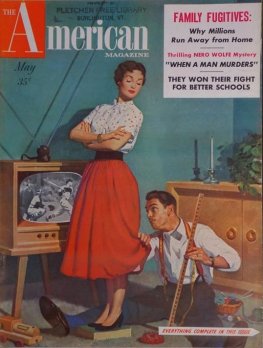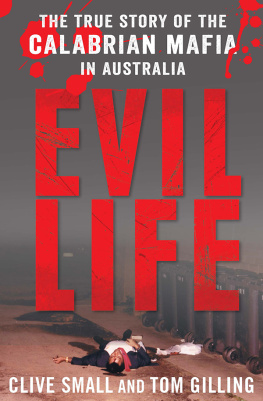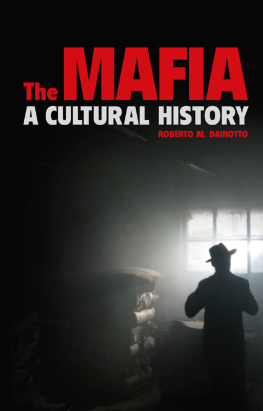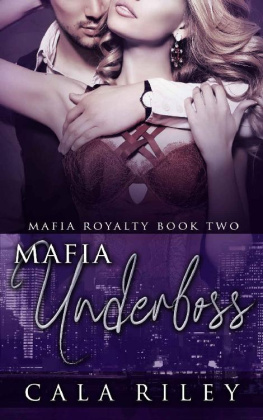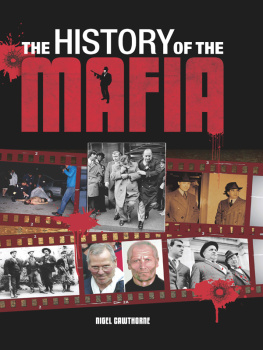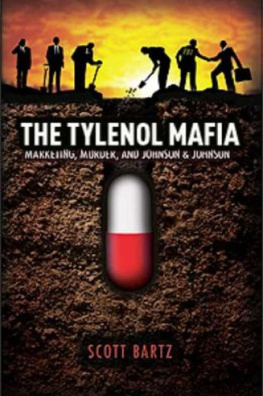M. A. Frasca - Mafia Murders
Here you can read online M. A. Frasca - Mafia Murders full text of the book (entire story) in english for free. Download pdf and epub, get meaning, cover and reviews about this ebook. year: 2021, publisher: Arcturus Digital Limited, genre: Non-fiction. Description of the work, (preface) as well as reviews are available. Best literature library LitArk.com created for fans of good reading and offers a wide selection of genres:
Romance novel
Science fiction
Adventure
Detective
Science
History
Home and family
Prose
Art
Politics
Computer
Non-fiction
Religion
Business
Children
Humor
Choose a favorite category and find really read worthwhile books. Enjoy immersion in the world of imagination, feel the emotions of the characters or learn something new for yourself, make an fascinating discovery.
- Book:Mafia Murders
- Author:
- Publisher:Arcturus Digital Limited
- Genre:
- Year:2021
- Rating:4 / 5
- Favourites:Add to favourites
- Your mark:
- 80
- 1
- 2
- 3
- 4
- 5
Mafia Murders: summary, description and annotation
We offer to read an annotation, description, summary or preface (depends on what the author of the book "Mafia Murders" wrote himself). If you haven't found the necessary information about the book — write in the comments, we will try to find it.
Mafia Murders — read online for free the complete book (whole text) full work
Below is the text of the book, divided by pages. System saving the place of the last page read, allows you to conveniently read the book "Mafia Murders" online for free, without having to search again every time where you left off. Put a bookmark, and you can go to the page where you finished reading at any time.
Font size:
Interval:
Bookmark:
You live by the gun and the knife and you die by the gun and the knife. Mob informant Joe Valachi to the McClellan Committee, 1963
The Mafia, or Cosa Nostra, first appeared in North America in the late 19th century, when gang members arriving from Italy, especially Sicily, settled in New York, Chicago and other urban centres, bringing their criminal ways with them. Loansharking, extortion, kidnapping, racketeeringthey did it all and their reach was growing. It wasnt long before these gangs were clashing with each other and with existing Jewish and Irish mobs as the newcomers gained a firm foothold in the New World.
The 1920s brought Prohibition and an unexpected windfall for the mobs. There was moneylots of itto be made from the illegal transportation and sale of liquor in the United States. America was dry and the mobs were eager to provide. Crime was bigger business than ever before and even the authorities were prepared to turn a blind eye in order to get their take. Criminals such as Jack Legs Diamond and Al Capone seemed to call the shots, but it was Lucky Luciano who became the pre-eminent mob boss and who created the Commission, the ruling body that to this day oversees all mob activity and disputes, thereby reducing in-fighting. It was also Luciano who divided the New York Mafia into five families and was shrewd enough to work with the Jewish and Irish mobs, making crime more efficient and truly organized.
It took a while for law enforcement officials to move effectively against the Mafia, some apparently not even realizingor not admitting publiclythat the organization existed. It wasnt until 1957, when police broke in on a high-level mob meeting taking place in Apalachin, New York, that the existence of the Mafia was unquestionably verified, with further confirmation provided by mobster Joe Valachi in 1963.
Following the creation of the Racketeer Influenced and Corrupt Organizations (RICO) Act in 1970, strong initiatives have been put in place to curb the power of the Mafia. Despite this, it remains a powerful force today, controlling organized crime operations in New York, Chicago and Montreal in particular. But the success of the Mafia would not have been possible without the ruthless methods that the crime bosses employed. Albert Mad Hatter Anastasia, Benjamin Bugsy Siegel, Big Paul Castellanothe list of Mafia victims seems endless. Mafia Hits lists the most important executionsthe rival bosses, the informers, the feuds, even some of the hit-men implicated in the assassination of President Kennedy. Theyre top of the lists of the made men, the associates and freelancers who paid the ultimate price.
Mobs proliferated in the major cities of nineteenth-century America, but they generally acted independently and were constantly at war with each other. Organized crime was yet to come.
Collusion between the gangs and political forces was marked, for politicians of all levels constantly used the brute force of the mobs in order to get ahead. The newspapers did the same thing, hiring gangs so they could muscle out the competition and expand their circulation.
Mobs such as the Five Points Gang and the Eastman Gang made life difficult for the average law-abiding citizen and honest cop alike. But there were other elements too. Black Hand extortion (used by Italian criminals preying exclusively on their fellow immigrants) was rife in cities, as was the more clannish Mafia itself.
Things were moving rapidly, however, as the century drew to a close. The old knuckle-busters were on their way out and mobsters such as Monk Eastman and Kid Twist Zwerbach were soon to take their final bows.
October 16, 1890
The murder of New Orleans Police Chief David Hennessy is considered to be one of the first recorded Mafia killings in America. Whether or not the Mafia was actually involved is unclear, but in the end it matters littlefor it was the Italian population of the city that bore the brunt of Hennessys death, on orders from the citys mayor, Joseph Shakspeare.
New Orleans during the late 1800s was a city of corruption and vice. Everyone was on the take, and that included officials. Even Shakspeare, who had been elected on an anti-corruption platform, was known to receive regular illicit payments from the gambling dens and brothels.
For years countless waves of immigrants had been pouring into the city, with Italians being currently bottom of the pecking order. Mixed in with these migrants were members of the Camorra and Mafia, who jostled for position in the citys underworld. Two rival familiesthe Provenzano and the Matranganow vied for a piece of the criminal pie.
Descriptions of Hennessy vary widely. He was either an honest cop trying to put a lid on the gang problem, or a crooked opportunist hoping to manipulate the underworld for his own purposes. Certainly Hennessy was no wallflower. Back in 1882 he had killed a rival officer in a shoot-out. The incident had cost him his job. Then, more recently as a crony of Mayor Shakspeare, he had not only found his badge reinstated, he had been appointed Chief of Police.
One of Hennessys first tasks as chief of a force that was corrupt and riddled with political appointees was to lop off some of the dead wood. As a result, scores of lawmen lost their jobs. Next, he moved to crack down on the gambling dens and casinosbut only those not owned by members of Shakspeares constituency. Evidently the clean-up went only so far.
Hennessy was also manoeuvring among the gangs. In an attempt to neutralize the more powerful of the two familiesthe Matrangahe had agreed to testify on behalf of the Provenzano if they promised to reveal all they knew about the Mafia.
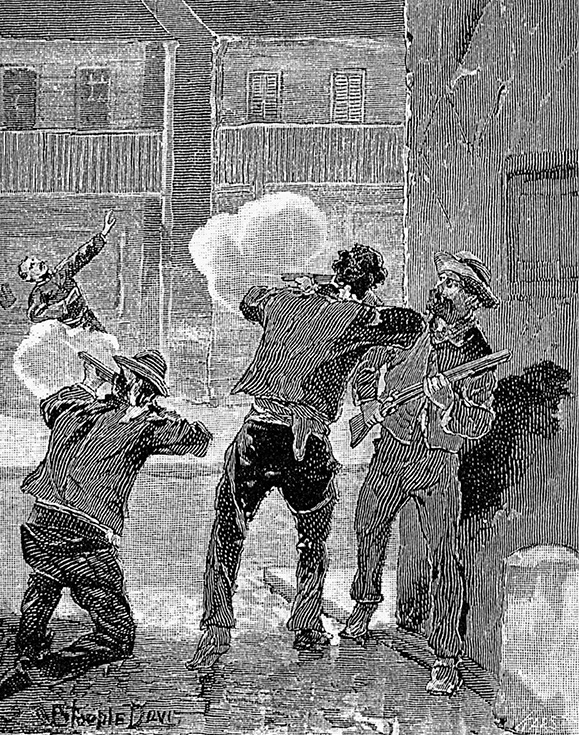
The shooting of Chief of Police David Hennessey who had been investigating crimes connected with the Mafia in New Orleans, 15th of October 1890.
Hennessy was never able to testify. On October 15, 1890, he was shot down on his way home. Lingering for about a day, he was able to provide only three words of information as to the identity of his killers: Dagoes did itmeaning the Italians.
But this was all Mayor Shakspeare needed to hear and he leapt at the chance to eliminate a painful thorn in his side. Immediately he ordered the police force to round up as many Italians as they could. Accounts differ as to how many were arrested in the witch-hunt, but figures range from 100 to 250a number well beyond the usual suspects. Only nine of these actually went to trial.
The trial was a fiasco from the start and both sides were accused of bribery and jury-tampering. In the end the judge had no alternative but to return an overall verdict of not guilty.
New Orleans was stunned. Agents of the mayor jumped on the soapbox and after a mass meeting the jail was stormed. When the smoke cleared, eleven prisoners were dead.
Yet even at the time opinion was divided as to who had actually killed Hennessy. Some dismissed Mafia involvement and believed the chiefs death to be the work of either ex-lawmen or gamblers who had suffered as a result of Hennessys clean-ups.
Nevertheless, anti-Italian sentiment lingered in New Orleans for years, with other ethnic Italians falling victim to the public mood. But the incident had further legacies too. The term Mafia, once known only by a few, was now a household word. Its also said that because of the murders the American Mafia made it a hard and fast rule to never kill a cop. The price is just too high.
Font size:
Interval:
Bookmark:
Similar books «Mafia Murders»
Look at similar books to Mafia Murders. We have selected literature similar in name and meaning in the hope of providing readers with more options to find new, interesting, not yet read works.
Discussion, reviews of the book Mafia Murders and just readers' own opinions. Leave your comments, write what you think about the work, its meaning or the main characters. Specify what exactly you liked and what you didn't like, and why you think so.


